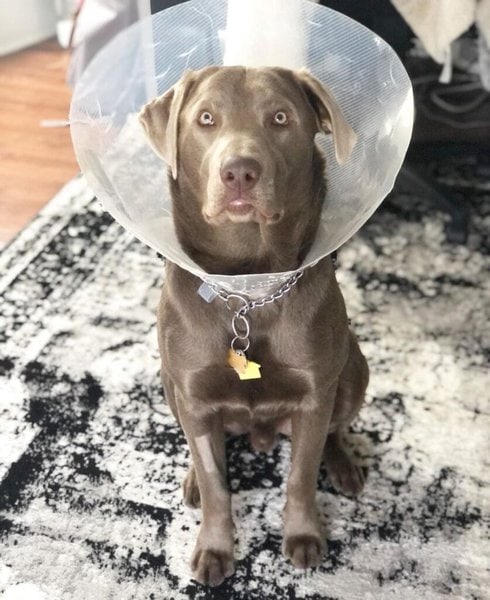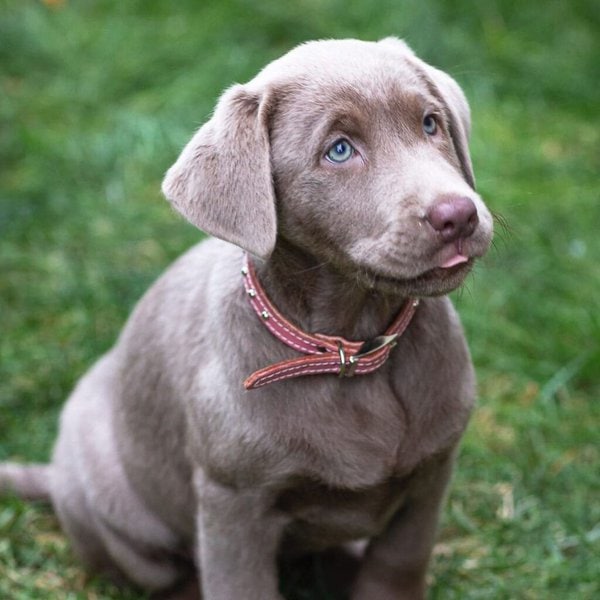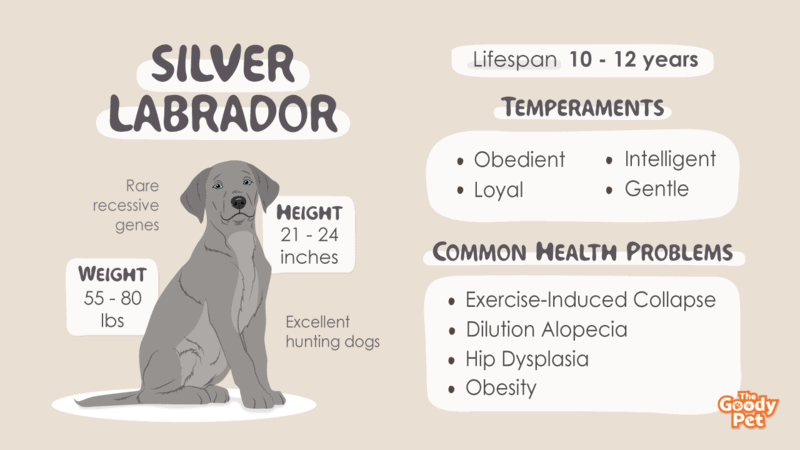Labrador Retrievers have consistently ranked among the top 5 most popular dog breeds for the last several years, according to the American Kennel Club. I am a huge fan of the dog breed, especially for its versatility. Whether you want a loyal and loving companion or an intelligent working dog, Labradors are always up to the task.
Silver Labradors are a color variation of the Labrador Retriever dog breed known for their greyish-silver coats. This appears as a watered-down and almost powdery chocolate brown shade. Other than the coat color, the Silver Labrador is similar in other physical features and in temperaments to that of standard color Labradors.
Despite the general similarities, there are a few differences, especially when it comes to the care needs of Silver Labradors. In the sections below, we shall cover all these and anything else you may need to know before owning a Silver Lab.
Where Did Silver Labs Originate?

There is a long-running controversy in the dog world, especially among Labrador breed enthusiasts and experts, about whether or not the Silver Lab is actually purebred. The short answer is that no one knows for sure.
There are currently two working theories on where the Silver Lab came from. The first is based on the presence of a dilution gene that acts on Chocolate Labrador lineages to produce the color. The second proposes that Silver Labs were a result of mixed breeding between Labradors and Weimaraner dogs known for having the same coat color.
Whether the Silver Lab is originally a part Weimaraner mutt or a purebred Labrador Retriever, they are in many ways physically similar to other Labs. Here are some of their key features.
Size And Build
Silver Labradors grow as big as 55 to 80 lbs in weight and be around 21 to 24 inches in height.
They have a solid, muscular build with a wide chest and otherwise very proportional features.
Coat Type
The coat on a Silver Labrador should be short, straight, and very dense. It may look smooth or even glossy but is usually fairly coarse to the touch.
Facial Features And Skull
Silver Labradors have the classic Lab wedge-shaped skull with a long narrow snout and wide cheeks and forehead. Their ears are large and floppy, and their eyes are medium-sized and wide-set.
The eyes of a Silver Lab stand out the most and are usually blue at birth. However, they change over the first few months to yellow, amber, or hazel.
Do Silver Labs Have More Health Issues?

Silver Labradors have a lifespan of 10 to 12 years but may live up to 14 years or more in some rare cases.
This is pretty much what is expected of most healthy dogs in the Labrador breed.
The problem with Silver Labs is that their production often involves a lot of inbreeding. As a result, this leads to some health issues unique to the variation in addition to those that affect Labrador Retrievers in general.
Here are some of the health issues you may find in a Silver Labrador.
Dilution Alopecia
You may notice that your Silver Labrador sheds a lot and may even lose clumps of hair from some sections of the coat. This is likely a result of a condition known as dilution alopecia.
It is theorized that the genes responsible for the dilution of the coat also cause the weakening of the fur strands at the roots and shaft, resulting in heavy shedding.
Hip Dysplasia
Hip dysplasia is a condition where the hip joint on the Silver Labrador forms abnormally and becomes unstable. With time, this affects all the surrounding structures, including the cartilage and tendons, and may cause complications like abnormal gait and arthritis.
Exercise-Induced Collapse
The exercise-induced collapse in Silver Labradors is a rare and dramatic condition. It causes an inability to tolerate exercise for more than 20 minutes, after which the dog’s legs literally fail them.
Exercise-induced collapse is a genetic condition and occurs mainly with inbred Silver Labs whose parents had the same issue.
Obesity
Silver Labradors, in general, are at a very high risk of obesity due to their high appetite as well as health issues that may affect mobility and activity levels. It is therefore very important to stick to a healthy and balanced diet for the sake of the dog.
How Much Does A Silver Lab Cost?

A Silver Labrador could cost you anywhere from $800 to $1,500.
This price is relatively high, especially when compared to Regular Labradors which can cost as low as $500 and very rarely exceed the $1,000 price point.
So what is it about Silver Labs that makes them so popular? Here are some reasons.
Silver Labs Are Rare
Silver Labradors occur as a result of rare, recessive genes.
As a result, it is not very easy to come by Labrador in a regular litter. The rarity makes them very expensive, especially in parts of the country where you may have to have the Silver Lab pups flown in from elsewhere.
Silver Labs Have Niche Demand
Silver Labradors are very beautiful and unique-looking dogs. This makes them fit in perfectly in niche demand groups for dogs with unique aesthetics. Some breeders take advantage of the hype behind Silver Labradors to put high price tags on the pups.
Silver Labs Are Expensive To Breed
Silver Labradors are more often than not bred from other Silver Labradors. Finding studs and females for the pairing is not always easy, and breeders often have to pay a lot of money for access.
There is also often the additional cost of genetic screening and selective breeding to avoid having unwanted traits and health issues passed on to the offspring. All these costs trickle down to potential Silver Lab owners.
Silver Labs Are Versatile Thus Worth The Money
This is more of a reason why Silver Labradors are worth the money. These dogs can fit into pretty much any household, whether it is a family setup, where they live as companions, or in working dog setups. With this trait, the value of your investment is pretty much a guarantee.
Are Silver Labs Good Hunting Dogs? Temperaments Of Silver Labradors

Silver Labrador Retrievers are excellent hunting dogs. Like the rest of the Labrador breed, they were initially developed and trained for hunting with tasks ranging from tracking and chasing to safe retrieval.
Today, they are often kept as companion dogs which is a job they do just as well as the hunting job. Here are a few of the Silver Labrador’s temperament traits that make this versatility possible.
Intelligent
Silver Labradors are pretty smart and quite easy to train. The dogs are responsive to commands and always ready to learn. You just need a good reward system to keep them invested in the training.
Obedient And Eager To Please
Another personality trait that makes Silver Labs easy to train and generally easy to live with is their obedience. These dogs live to serve and please their human companions. They are therefore ideal for first-time dog owners and family settings.
Social
Silver Labradors love to be around people.
The super friendly doggies are social with everyone, including strangers, and are therefore awesome to have if you have a busy home. They also tend to get along fairly well with other pets, especially if socialized from an early age.
Loyal
Silver Labradors form a very strong bond with humans that they get to spend time with, especially those who care for the dog. They will never forget the kindness and love shown to them and reciprocate with affection and unwavering loyalty.
Gentle And Even-Tempered
Silver Labradors are generally strong and confident dogs. However, they are not known to be aggressive but are instead among the sweetest and most even-tempered dogs. They are perfect for raising young children.
Do Silver Labs Shed A Lot? Grooming Tips For Silver Labradors
Silver Labradors have short and dense coats that shed between moderate to heavy levels.
They are also predisposed to skin issues, including alopecia. This makes coat care a crucial aspect of grooming that you simply cannot afford to slack on.
To help you better take care of your Silver Lab pooch, here are a few care tips.
Brush The Silver Lab’s Coat Frequently
Frequent brushing does a lot to minimize shedding and helps keep your dog’s coat looking healthy and beautiful. With Silver Labradors, brushing them 3 to 4 times each week should help a lot.
This regular grooming also helps to minimize the amount of loose fur you will have lying around in your home. For the little fur that does make it to the floor, the iRobot Roomba i3+ will come in very handy.
This automated vacuum is designed to pick up after your doggy and will do a better job vacuuming fur than most other vacuums.
Invest In Appropriate Grooming Tools
In addition to finding a good brushing schedule, you have to invest in high-quality grooming tools for your Silver Labrador. We recommend the FURminator Undercoat Tool for de-shedding and detangling.
With its strong, metal bristles, this dog grooming brush will get through the thick coat of your Silver Lab with ease.
Use Gentle And Quality Shampoo
Due to the Silver Labrador’s sometimes problematic skin and fur, you have to choose your shampoo very carefully. We recommend Paws & Pals 6-In-1 Oatmeal Dog Shampoo to keep your Silver Lab’s fur smooth, clean, and smelling fantastic.
This amazing shampoo combines a bunch of benefits into one bottle, including conditioning, soothing irritated skin, and odor control.
Related Questions
Do Silver Labs Eyes Stay Blue? Silver Labrador eyes do not stay blue. As the dog gets older, the eyes get more melanin, and the color changes from blue to yellow, amber, or hazel. This will usually have happened by the time the puppy is 6 to 8 months of age but may take up to a year in some cases.
Are Charcoal And Silver Labs The Same? Charcoal and Silver Labrador are not the same despite the common misconception. Charcoal Labradors have a diluted black coat, while Silver Labradors have diluted chocolate coats. While they may appear similar with their greyish coats, Charcoal Labs tend to be darker, while Silver Labs have a more reddish-brown hue.
What Color Labs Do You Breed To Get Silver? You have to breed two Silver Labradors in order to get Silver Lab pups. This is because the genes responsible are recessive, which means that both parents need to also be carriers of the recessive copies for the coat to be expressed. Silver Labs could also come from Chocolate parents who carry unexpressed gene forms responsible for dilution.





